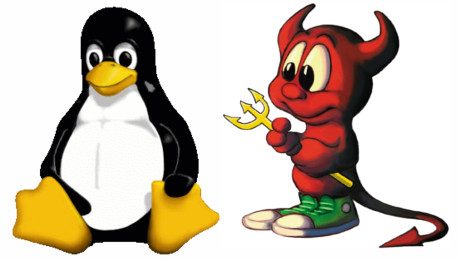
There a lot of tutorials out there explaining how to dual boot Linux and FreeBSD on legacy BIOS but not so much for UEFI only systems. So I will share my experience installing Debian 10.2 and FreeBSD 12.1 on my ThinkPad X250 in UEFI only mode. It should be easy to adapt this to other Linux distributions and other systems than FreeBSD.
This post will be soon followed by another post explaining how FreeBSD and Linux can get along with each other after being installed. But now for the installation.
First ensure in your UEFI/BIOS settings that boot is set to UEFI only and CSM disabled. You don’t want to boot the installer in legacy mode by accident.
We will use a GTP partition table and the create the following partitions:
- EFI System Partition (ESP): To store the UEFI bootloaders
- SWAP + ext4: For Linux
- SWAP + UFS: For FreeBSD
Note that we could technically use the same SWAP for both FreeBSD and Linux. Still I prefer to use 2 SWAP partitions and use both of them in each OS. It’s a matter of preference I guess.
Install Linux and FreeBSD
Install Linux
We start installing Debian so that Linux stays in charge of GRUB. We do so because it’s frequent on Linux to have multiple kernel variants, for instance a more recent version of the kernel, custom or a RT patched kernel. So we let Linux’s package manager handle all of that.
At the partitioning step, select “Manual partitioning” and create a GPT partition table. For UEFI to function properly, we need a EFI System Partition (ESP), 500MB should be more than enough for this. Then a Linux swap partition and a Linux ext4 partition for the data. Leave some space unallocated for FreeBSD.
It is possible to use Linux’s swap partition in FreeBSD. More about that later. For now we will let each OS have its own swap partition.
Complete the Debian installation. It should install grub bootloader in the EFI partition. Check that Debian boots properly. Then start the FreeBSD install.
Install FreeBSD
There used to be a separate installation image for FreeBSD UEFI. This is not the case anymore, so you can use the AMD64 memstick image for 12.1-RELEASE on the FreeBSD download page.
Boot the installer and go ahead up to the partitioning step. Use the space you left unallocated for the freebsd-swap and freebsd-ufs partitions. The installer will complain that an EFI partition is required for the system to work properly and propose to create it. Ignore this as the partition was already created under Linux. It is weird though that the FreeBSD installer does not detect this, but there is a FreeBSD forum post about this issue.
Proceed and complete the FreeBSD installation. Then reboot into Debian to configure the dual boot.
GRUB dual boot
It is now time to tell Linux’s GRUB about our newly installed FreeBSD system.
We created the swap partitions before the data partitions for each OS, so to resume our partition table we now have:
- EFI System Partition
- Linux SWAP
- Linux ext4
- FreeBSD SWAP
- FreeBSD UFS
So our FreeBSD partition is (hd0, gpt5) in GRUB parlance. You may need to adapt this to your own partition scheme though. Once in Debian as root edit /etc/grub.d/40_custom and after the comment add:
menuentry 'FreeBSD' {
insmod ufs2
set root='(hd0,gpt5)'
chainloader /boot/loader.efi
}
If you want, you can also configure FreeBSD as the default entry by editing /etc/default/grub and change DEFAULT=0 to DEFAULT=FreeBSD.
Then update grub with update-grub2, finally reboot and select FreeBSD in the GRUB menu. You can now boot both Linux and FreeBSD.
FreeBSD aware UEFI
It is now possible to boot both Debian and FreeBSD from GRUB. However it is not yet possible to boot FreeBSD directly from UEFI. To do so we need to copy the FreeBSD UEFI loader in to EFI partition and register it. Debian already mounts the EFI partition but FreeBSD doesn’t, so for the fun of it, let’s manage all that under FreeBSD and install the FreeBSD UEFI loader. /dev/ada0p1 is the EFI partition, but you may need to adapt this to your partition scheme though.
# We mount the EFI partition on /boot/efi similarly to Linux.
mkdir /boot/efi
echo '/dev/ada0p1 /boot/efi msdosfs rw,noatime 0 0' >> /etc/fstab
mount /boot/efi
# Install the FreeBSD UEFI loader.
mkdir /boot/efi/EFI/freebsd
cp /boot/boot1.efi /boot/efi/EFI/freebsd/bootx64.efi
Now let’s create an UEFI entry for this loader. Note that this is for FreeBSD’s efibootmgr, not the Linux’s one.
# Create the boot variable.
efibootmgr -c -l /boot/efi/EFI/freebsd/bootx64.efi -L "FreeBSD"
# Check the variable number for the new boot variable and activate it.
efibootmgr
efibootmgr -a 15
# Change the boot order to leave Debian and GRUB in charge.
efibootmgr -o 14,15
Time to reboot! Select the boot menu with (generally with F12, at least on my ThinkPad X250) and FreeBSD should appear. Select it and it should boot FreeBSD directly.
You are done! Next time how to let FreeBSD and Linux talk to each other.

